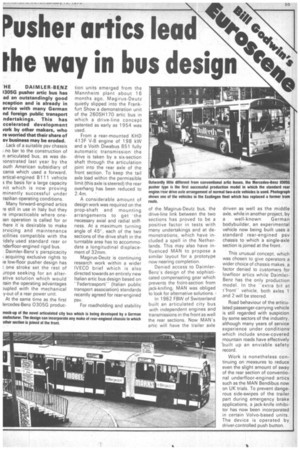Pusher artics lead the way in bus design
Page 57

If you've noticed an error in this article please click here to report it so we can fix it.
'HE DAIMLER-BENZ /305G pusher artic bus has ad an outstandingly good aception and is already in ervice with many German nd foreign public transport ndertakings. This has ccelerated development work by other makers, who re worried that their share of sv business may be eroded. Lack of a suitable psv chassis ; no bar to the construction of n articulated bus, as was delonstrated last year by the outh American subsidiary of cania which used a forward, ertical-engined B111 vehicle s the basis for a large capacity nit which is now proving minently successful under razilian operating conditions. Many forward-engined artics re still in use in Italy but they re impracticable where one)an operation is called for or there it is desirable to make arvicing and maintenance icilities compatible with the 'idely used standard rear or nderfloor-engined rigid bus. Daimler-Benz's perspicacity acquiring exclusive rights to le low-floor pusher design has
t one stroke set the rest of J rope seeking for an alterative solution which would tain the operating advantages Jupled with the mechanical y-out of a rear power unit.
At the same time as the first lercedes-Benz 0305G produc
tion units emerged from the Mannheim plant about 16 months ago, Magirus-Deutz quietly slipped into the Frankfurt Show a demonstration unit of the 260SH170 artic bus in which a drive-line concept patented as early as 1954 was used.
From a rear-mounted KHD 413F V-8 engine of 198 kW and a Voith Diwabus 851 fully automatic transmission the drive is taken by a six-section shaft through the articulation joint into the rear axle of the front section. To keep the tail axle load within the permissible limit (this axle is steered) the rear overhang has been reduced to 2.4m.
A considerable amount of design work was required on the prop-shaft and mounting arrangements to get the necessary axial and radial stiffness. At a maximum turning angle of 45' , each of the two sections of the drive shaft in the turntable area has to accommodate a longitudinal displacement of 32mm.
Magirus-Deutz is continuing research work within a wider IVECO brief which is also directed towards an entirely new Italian artic bus design based on -Federtrasporti' (Italian public transport association) standards recently agreed for rear-engined psv.
For roadholding and stability of the Magirus-Deutz bus, the drive-line link between the two sections has proved to be a positive factor in tests with many undertakings and at demonstrations, which have included a spell in the Netherlands. This may also have influenced MAN to propose a similar layout for a prototype now nearing completion.
Denied access to DaimlerBenz's design of the sophisticated compensating gear which prevents the front-section from jack-knifing. MAN was obliged to look for alternative solutions.
In 1962 FBW of Switzerland built an articulated city bus with independent engines and transmissions in the front as well the rear sections. Now MAN's artic will have the trailer axle driven as well as the middle axle, while in another project, by a well-known German bodybuilder, an experimental vehicle now being built uses a standard rear-engined psv chassis to which a single-axle section is joined at the front.
This unusual concept, which was chosen to give operators a wider choice of chassis makes, a factor denied to customers for lowfloor artics while DaimlerBenz has the only production model. In the -extra bit at ffront" vehicle, both axles 1 and 2 will be steered.
Road behaviour of the articulated passenger-carrying vehicle is still regarded with suspicion by some sectors of the industry, although many years of service experience under conditions. which include snow-covered mountain roads have effectively 'built up an enviable safety record.
Work is nonetheless continuing on measures to reduce even the slight amount of sway of the rear section of conventional underfloor-engined artics such as the MAN Bendibus now on UK trials. To prevent dangerous side-swipes of the trailer part during emergency brake applications, a jack-knife inhibitor has now been incorporated in certain Volvo-based units. The device is operated by driver-controlled push button.




































































































